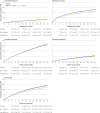ADHD drug treatment and risk of suicidal behaviours, substance misuse, accidental injuries, transport accidents, and criminality: emulation of target trials
- PMID: 40803836
- PMCID: PMC12344785
- DOI: 10.1136/bmj-2024-083658
ADHD drug treatment and risk of suicidal behaviours, substance misuse, accidental injuries, transport accidents, and criminality: emulation of target trials
Abstract
Objective: To examine the effects of drug treatment for attention deficit/hyperactivity disorder (ADHD) on suicidal behaviours, substance misuse, accidental injuries, transport accidents, and criminality.
Design: Emulation of target trials.
Setting: Linkage of national registers in Sweden, 2007-20.
Participants: People aged 6-64 years with a new diagnosis of ADHD, who either started or did not start drug treatment for ADHD within three months of diagnosis.
Main outcome measures: First and recurrent events of five outcomes over two years after ADHD diagnosis: suicidal behaviours, substance misuse, accidental injuries, transport accidents, and criminality.
Results: Of 148 581 individuals with ADHD (median age 17.4 years; 41.3% female), 84 282 (56.7%) started drug treatment for ADHD, with methylphenidate being the most commonly prescribed at initiation (74 515; 88.4%). Drug treatment for ADHD was associated with reduced rates of the first occurrence of suicidal behaviours (weighted incidence rates 14.5 per 1000 person years in the initiation group versus 16.9 in the non-initiation group; adjusted incidence rate ratio 0.83, 95% confidence interval 0.78 to 0.88), substance misuse (58.7 v 69.1 per 1000 person years; 0.85, 0.83 to 0.87), transport accidents (24.0 v 27.5 per 1000 person years; 0.88, 0.82 to 0.94), and criminality (65.1 v 76.1 per 1000 person years; 0.87, 0.83 to 0.90), whereas the reduction was not statistically significant for accidental injuries (88.5 v 90.1 per 1000 person years; incidence rate ratio 0.98, 0.96 to 1.01). The reduced rates were more pronounced among individuals with previous events, with incidence rate ratios ranging from 0.79 (0.72 to 0.86) for suicidal behaviours to 0.97 (0.93 to 1.00) for accidental injuries. For recurrent events, drug treatment for ADHD was significantly associated with reduced rates of all five outcomes, with incidence rate ratios of 0.85 (0.77 to 0.93) for suicidal behaviours, 0.75 (0.72 to 0.78) for substance misuse, 0.96 (0.92 to 0.99) for accidental injuries, 0.84 (0.76 to 0.91) for transport accidents, and 0.75 (0.71 to 0.79) for criminality.
Conclusions: Drug treatment for ADHD was associated with beneficial effects in reducing the risks of suicidal behaviours, substance misuse, transport accidents, and criminality but not accidental injuries when considering first event rate. The risk reductions were more pronounced for recurrent events, with reduced rates for all five outcomes. This target trial emulation study using national register data provides evidence that is representative of patients in routine clinical settings.
© Author(s) (or their employer(s)) 2019. Re-use permitted under CC BY. No commercial re-use. See rights and permissions. Published by BMJ.
Conflict of interest statement
Competing interests: All authors have completed the ICMJE uniform disclosure form at https://www.icmje.org/disclosure-of-interest/ and declare: support from the Swedish Research Council for Health, Working Life and Welfare; the Swedish Research Council, ìShizu Matsumuraîs Donation, KI Research Grants, the Swedish Heart-Lung Foundation, the Söderström König Foundation, Fredrik och Ingrid Thurings Stiftelse, the American Foundation for Suicide Prevention, the National Institute for Health and the Care Research, and the European Research Executive Agency; HL has received grants from Shire Pharmaceuticals, personal fees from, and has served as a speaker for, Medici, Shire/Takeda Pharmaceuticals, and Evolan Pharma AB, and sponsorship for a conference on ADHD from Shire/Takeda Pharmaceuticals and Evolan Pharma AB, all outside the submitted work; SC has received reimbursement for travel and accommodation expenses from the Association for Child and Adolescent Mental Health (ACAMH) in relation to lectures delivered for ACAMH, the Canadian ADHD Alliance Resource, the British Association of Psychopharmacology, and the Healthcare Convention and CCM Group team for educational activity on ADHD; SC has also received honorariums from Medice and serves as chair of the European ADHD Guidelines Group, all outside the submitted work; ZC has received speaker fees from Takeda Pharmaceuticals, outside the submitted work; no other relationships or activities that could appear to have influenced the submitted work.
Figures






References
MeSH terms
Substances
LinkOut - more resources
Full Text Sources
Medical
